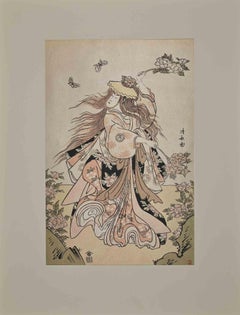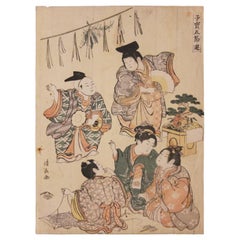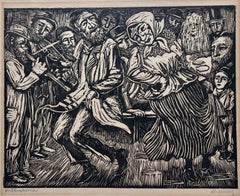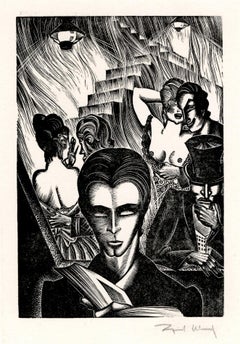Torii Kiyonaga Figurative Prints
1
to
2
1
3
3
Overall Height
to
Overall Width
to
1
3
3
2
1
1
1
1
1
1
1
4
563
395
350
305
3
Artist: Torii Kiyonaga
Actor Segawa Kikunojô III - Woodcut after Torii Kiyonaga - Mid-20th Century
By Torii Kiyonaga
Located in Roma, IT
Actor Segawa Kikunojô III Performing the Lion Dance is a woodcut print realized in the early 20th Century after Torii Kiyonaga's Woodcut.
Good conditions....
Category
Early 20th Century Modern Torii Kiyonaga Figurative Prints
Materials
Woodcut
Beauties under a Maple Tree Japanese Woodblock Print
By Torii Kiyonaga
Located in Houston, TX
Three Beauties under a maple tree from the series "A Contest of Fashionable Beauties of the Gay Quarters". The woodblock print is printed on rice paper....
Category
1780s Edo Torii Kiyonaga Figurative Prints
Materials
Woodcut
New Year From the Series Precious Children's Games of the Five Festivals
By Torii Kiyonaga
Located in Houston, TX
Torii Kiyonaga woodblock print from the series "Prescious Children's Games of the Five Festivals." It shows five children playing with a ball and kites flying in the background. This...
Category
Early 1800s Edo Torii Kiyonaga Figurative Prints
Materials
Woodcut
Related Items
Jewish Wedding Judaica Woodblock Print c.1930s WPA Woodcut Print Hand Signed
By Albert Abramovitz
Located in Surfside, FL
Some of his prints were published by the WPA. it is a wood engraving signed in pencil. From a small edition.
Albert Abramovitz (1879-1963), bor...
Category
1930s American Impressionist Torii Kiyonaga Figurative Prints
Materials
Woodcut
'Madman's Drum (Plate 41)' — 1930s Graphic Modernism
By Lynd Ward
Located in Myrtle Beach, SC
Lynd Ward, 'Madman's Drum, Plate 41', wood engraving, 1930, edition small. Signed in pencil. A fine, black impression, on off-white tissue-thin Japan paper; the full sheet with margins (1 5/8 to 2 1/2 inches); a small paper blemish in the upper right margin, away from the image, otherwise in excellent condition. Scarce. Matted to museum standards, unframed.
Image size 5 1/2 x 3 3/4 inches (140 x 95 mm); sheet size 9 5/8 x 7 1/8 inches (244 x 181 mm).
From Lynd Ward’s book of illustrations without words, 'Madman’s Drum', Jonathan Cape and Harrison Smith, New York, 1930. Illustrated in 'Storyteller Without Words: The Wood Engravings of Lynd Ward', Harry Abrams, New York, 1974.
Reproduced in 'Storyteller Without Words, the Wood Engravings of Lynd Ward', Harry N. Abrams, New York, 1974.
ABOUT THE ARTIST
Lynd Ward is acknowledged as one of America’s foremost wood engravers and book illustrators of the first half of the twentieth century. His innovative use of narrative printmaking as a stand-alone storytelling vehicle was uniquely successful in reaching a broad audience. The powerful psychological intensity of his work, celebrated for its dynamic design, technical precision, and compelling dramatic content, finds resonance in the literature of Poe, Melville, and Hawthorne. Like these classic American writers, Ward was concerned with the themes of man’s inner struggles and the role of the subconscious in determining his destiny. An artist of social conscience during the Great Depression and World War II, he infused his graphic images with his unique brand of social realism, deftly portraying the problems that challenged the ideals of American society.
The son of a Methodist preacher, Lynd Ward, moved from Chicago to Massachusetts at an early age. He graduated from the Teachers College of Columbia University, New York, in 1926, where he studied illustration and graphic arts. He married May Yonge McNeer in 1936 and left for Europe for their honeymoon in Eastern Europe. After four months, they settled in Leipzig, where Ward studied at the National Academy of Graphic Arts and Bookmaking. Inspired by Belgian expressionist artist Frans Masereel's graphic novel ‘The Sun,’ and another graphic novel by the German artist Otto Nückel, ‘Destiny,’ he determined to create his own "wordless" novel. Upon his return to America, Ward completed his first book, ‘God's Man: A Novel in Woodcuts,’ published in 1929. ‘Gods’ Man’ was a great success for its author and publisher and was reprinted four times in 1930, including a British edition. This book and several which followed it, ‘Madman’s Drum,’ 1930, ‘Wild Pilgrimage...
Category
1930s American Modern Torii Kiyonaga Figurative Prints
Materials
Woodcut
"Thirsty: the appearance of a town geisha in the Ansei era" - Woodblock on Paper
By Tsukioka Yoshitoshi
Located in Soquel, CA
"Thirsty: the appearance of a town geisha in the Ansei era" - Woodblock on Paper
From the series "Thirty-two Aspects of Customs and Manners" (Fuzoku sanjuniso)
Lively woodblock of a...
Category
1880s Edo Torii Kiyonaga Figurative Prints
Materials
Paper, Ink, Woodcut
'The Aquarium' — WPA Era 1930s Graphic Modernism
By Fritz Eichenberg
Located in Myrtle Beach, SC
Fritz Eichenberg, 'The Aquarium', wood engraving, 1933, edition 200. Signed and titled in pencil. Initialed in the block, lower right. A superb, richly-inked impression, on pale yel...
Category
1930s American Modern Torii Kiyonaga Figurative Prints
Materials
Woodcut
Jonah
By Sadao Watanabe
Located in Santa Monica, CA
SADAO WATANABE (Japanese 1913-1996)
JONAH, 1959
Color stencil, signed, numbered and dated in white ink. Sheet, 25 5/8 x 22 5/8 inches. Edition: 44/50. Good color and generally good ...
Category
1950s Modern Torii Kiyonaga Figurative Prints
Materials
Stencil, Woodcut
Leonard Baskin Woodblock Broadside Print Woodcut Vintage Poster in Red and Black
By Leonard Baskin
Located in Surfside, FL
This is an original gallery show poster the Boris Mirsky Gallery, Newbury St. Boston. titled Sculpture Prints Drawings. It is dated 1962. it is in red and black.
Leonard Baskin (August 15, 1922 – June 3, 2000) was an American sculptor, illustrator, wood-engraver, printmaker, graphic artist, writer and teacher.
Baskin was born in New Brunswick, New Jersey. While he was a student at Yale University, he founded Gehenna Press, a small private press specializing in fine book production. From 1953 until 1974, he taught printmaking and sculpture at Smith College in Northampton, Massachusetts. Subsequently Baskin also taught at Hampshire College in Amherst, Massachusetts.
He lived most of his life in the U.S., but spent nine years in Devon at Lurley Manor, Lurley, near Tiverton, close to his friend Ted Hughes, for whom he illustrated Crow. Sylvia Plath dedicated Sculpto to Leonard Baskin in her famous work, The Colossus and Other Poems (1960).
The Funeral Contege (1997) bronze, Franklin Delano Roosevelt Memorial, Washington, D.C.
His public commissions include a bas relief for the Franklin Delano Roosevelt Memorial and a bronze statue of a seated figure, erected in 1994 for the Holocaust Memorial in Ann Arbor, Michigan.
His works are owned by many major museums including the Metropolitan Museum of Art, the Museum of Fine Arts, Boston, the Museum of Modern Art, the Art Institute of Chicago, the Boca Raton Museum of Art, the British Museum, the Honolulu Museum of Art, the Udinotti Museum of Figurative Art and the Vatican Museums. The archive of his work at the Gehenna Press was acquired by the Bodleian Library at Oxford, England, in 2009. The McMaster Museum of Art in Hamilton, Ontario owns over 200 of his works (some religious and biblical), most of which were donated by his brother Rabbi Bernard Baskin.
In 1955, he was one of eleven New York artists featured in the opening exhibition at the Terrain Gallery, they showed many great artists, Chaim Koppelman, for many years, headed the gallery's Print Division; printmakers such as Will Barnet, Leonard Baskin, Robert Conover...
Category
1960s Modern Torii Kiyonaga Figurative Prints
Materials
Woodcut
'Simplicius' Farewell to the World' — Graphic Modernism
By Fritz Eichenberg
Located in Myrtle Beach, SC
Fritz Eichenberg, 'Simplicius’ Farewell To The World' from the suite 'The Adventurous Simplicissimus', wood engraving, 1977, artist's proof apart from the edition of 50. Signed in pencil. Signed in the block, lower right. A fine, richly-inked impression, on cream wove paper, with full margins (1 1/2 to 2 inches), in excellent condition. Image size 14 x 12 inches (356 x 305 mm); sheet size 17 1/2 x 15 inches (445 x 381 mm). Archivally sleeved, unmatted.
ABOUT THIS WORK
'Simplicius Simplicissimus' (German: Der abenteuerliche Simplicissimus Teutsch) is a picaresque novel of the lower Baroque style, written in five books by Hans Jakob Christoffel von Grimmelshausen published in 1668, with the sequel Continuatio appearing in 1669.
The novel is told from the perspective of its protagonist Simplicius, a rogue or picaro typical of the picaresque novel, as he traverses the tumultuous world of the Holy Roman Empire during the Thirty Years' War. Raised by a peasant family, he is separated from his home by foraging dragoons. He is adopted by a hermit living in the forest, who teaches him to read and introduces him to religion. The hermit also gives Simplicius his name because he is so simple that he does not know his own name. After the death of the hermit, Simplicius must fend for himself. He is conscripted at a young age into service and, from there, embarks on years of foraging, military triumph, wealth, prostitution, disease, bourgeois domestic life, and travels to Russia, France, and an alternate world inhabited by mermen. The novel ends with Simplicius turning to a life of hermitage, denouncing the world as corrupt.
ABOUT THE ARTIST
Fritz Eichenberg (1901–1990) was a German-American illustrator and arts educator who worked primarily in wood engraving. His best-known works were concerned with religion, social justice, and nonviolence.
Eichenberg was born to a Jewish family in Cologne, Germany, where the destruction of World War I helped to shape his anti-war sentiments. He worked as a printer's apprentice and studied at the Municipal School of Applied Arts in Cologne and the Academy of Graphic Arts in Leipzig, where he studied under Hugo Steiner-Prag. In 1923 he moved to Berlin to begin his career as an artist, producing illustrations for books and newspapers. In his newspaper and magazine work, Eichenberg was politically outspoken and sometimes wrote and illustrated his reporting.
In 1933, the rise of Adolf Hitler drove Eichenberg, who was a public critic of the Nazis, to emigrate with his wife and children to the United States. He settled in New York City, where he lived most of his life. He worked in the WPA Federal Arts Project and was a member of the Society of American Graphic Artists.
In his prolific career as a book illustrator, Eichenberg portrayed many forms of literature but specialized in works with elements of extreme spiritual and emotional conflict, fantasy, or social satire. Over his long career, Eichenberg was commissioned to illustrate more than 100 classics by publishers in the United States and abroad, including works by renowned authors Dostoyevsky, Tolstoy, Charlotte and Emily Brontë, Poe, Swift, and Grimmelshausen. He also wrote and illustrated books of folklore and children's stories.
Eichenberg was a long-time contributor to the progressive magazine The Nation, his illustrations appearing between 1930 and 1980. Eichenberg’s work has been featured by such esteemed publishers as The Heritage Club, Random House, Book of the Month Club, The Limited Editions Club, Kingsport Press, Aquarius Press, and Doubleday.
Raised in a non-religious family, Eichenberg had been attracted to Taoism as a child. Following his wife's unexpected death in 1937, he turned briefly to Zen Buddhist meditation, then joined the Religious Society of Friends in 1940. Though he remained a Quaker until his death, Eichenberg was also associated with Catholic charity work through his friendship with Dorothy Day...
Category
1970s American Modern Torii Kiyonaga Figurative Prints
Materials
Woodcut
Coal Miners - INDUSTRIAL ART - Pre War German School - Large signed Woodcut
Located in Meinisberg, CH
Hermann Kätelhön
(German, * 22. September 1884, Hofgeismar; † 24. November 1940, München)
Coal Miners
• Woodcut, sheet measures ca. 55 x 40 cm
• The sheet is mounted (fixed at the...
Category
1920s Naturalistic Torii Kiyonaga Figurative Prints
Materials
Paper, Ink, Woodcut
Free Shipping
H 21.66 in W 15.75 in D 0.4 in
Jewish Rabbi with Torah German Expressionist Woodcut Israeli Early Bezalel
By Jacob Steinhardt
Located in Surfside, FL
Hand signed in pencil, woodblock print woodcut.
Jacob Steinhardt
1887-1968
Steinhardt, Jakob, Painter and Woodcut Artist. b. 1887, Yaacov Steinhardt was born in the then remote,...
Category
20th Century Expressionist Torii Kiyonaga Figurative Prints
Materials
Woodcut
Leonard Baskin Woodblock Broadside Print Woodcut Vintage Poster in Red and Black
By Leonard Baskin
Located in Surfside, FL
This is an original gallery show poster the Boris Mirsky Gallery, Newbury St. Boston. titled Sculpture Prints Drawings. It is dated 1962. it is in red and black.
Leonard Baskin (August 15, 1922 – June 3, 2000) was an American sculptor, illustrator, wood-engraver, printmaker, graphic artist, writer and teacher.
Baskin was born in New Brunswick, New Jersey. While he was a student at Yale University, he founded Gehenna Press, a small private press specializing in fine book production. From 1953 until 1974, he taught printmaking and sculpture at Smith College in Northampton, Massachusetts. Subsequently Baskin also taught at Hampshire College in Amherst, Massachusetts.
He lived most of his life in the U.S., but spent nine years in Devon at Lurley Manor, Lurley, near Tiverton, close to his friend Ted Hughes, for whom he illustrated Crow. Sylvia Plath dedicated Sculpto to Leonard Baskin in her famous work, The Colossus and Other Poems (1960).
The Funeral Contege (1997) bronze, Franklin Delano Roosevelt Memorial, Washington, D.C.
His public commissions include a bas relief for the Franklin Delano Roosevelt Memorial and a bronze statue of a seated figure, erected in 1994 for the Holocaust Memorial in Ann Arbor, Michigan.
His works are owned by many major museums including the Metropolitan Museum of Art, the Museum of Fine Arts, Boston, the Museum of Modern Art, the Art Institute of Chicago, the Boca Raton Museum of Art, the British Museum, the Honolulu Museum of Art, the Udinotti Museum of Figurative Art and the Vatican Museums. The archive of his work at the Gehenna Press was acquired by the Bodleian Library at Oxford, England, in 2009. The McMaster Museum of Art in Hamilton, Ontario owns over 200 of his works (some religious and biblical), most of which were donated by his brother Rabbi Bernard Baskin.
In 1955, he was one of eleven New York artists featured in the opening exhibition at the Terrain Gallery, they showed many great artists, Chaim Koppelman, for many years, headed the gallery's Print Division; printmakers such as Will Barnet, Leonard Baskin, Robert Conover...
Category
1960s Modern Torii Kiyonaga Figurative Prints
Materials
Woodcut
Judaica Woodcut Print Jewish Rabbi Hachnasas Torah Procession Woodblock
Located in Surfside, FL
This does not appear to be signed. not examined out of frame. In the manner of Frans Masereel here is an old woodblock print of a Jewish religious scene of the induction of a new torah in a procession with a chuppah, wedding canopy. In the tradition of the Jewish European artists of the 19th and early 20th centuries, such as Moritz Oppenheim, Max Liebermann, Lesser Ury, Jakob Steinhardt, Jehudo Epstein, Artur Kolnik, Stanislaus Bender...
Category
Early 20th Century Realist Torii Kiyonaga Figurative Prints
Materials
Woodcut
A Mother Takes her Son for A Walk during the Russo-Japanese War.
By Toyohara Chikanobu
Located in Storrs, CT
c. 1883. Kakemono: 28 3/8 x 9 7/16. Repairs and staining; fine color. An extremely scarce historical image. Signed Chikanobu. Housed in a 36 x 15 1/2-inch archival mat, ready for your choice of frame.
The Russo-Japanese War...
Category
Late 19th Century Edo Torii Kiyonaga Figurative Prints
Materials
Color, Woodcut
H 28.13 in W 9.44 in D 0.5 in
Torii Kiyonaga figurative prints for sale on 1stDibs.
Find a wide variety of authentic Torii Kiyonaga figurative prints available for sale on 1stDibs. You can also browse by medium to find art by Torii Kiyonaga in woodcut print and more. Much of the original work by this artist or collective was created during the 18th century and is mostly associated with the modern style. Not every interior allows for large Torii Kiyonaga figurative prints, so small editions measuring 9 inches across are available. Customers who are interested in this artist might also find the work of Kunichika Toyohara, Utagawa Hiroshige (Ando Hiroshige), and Utagawa Kunisada (Toyokuni III). Torii Kiyonaga figurative prints prices can differ depending upon medium, time period and other attributes. On 1stDibs, the price for these items starts at $110 and tops out at $900, while the average work can sell for $900.




